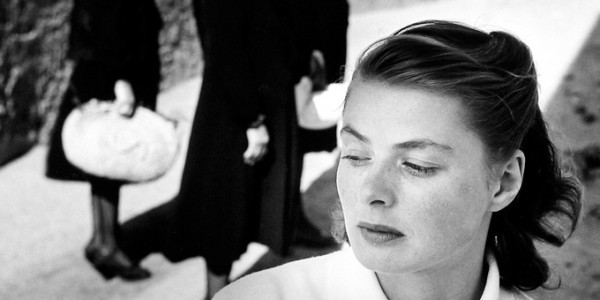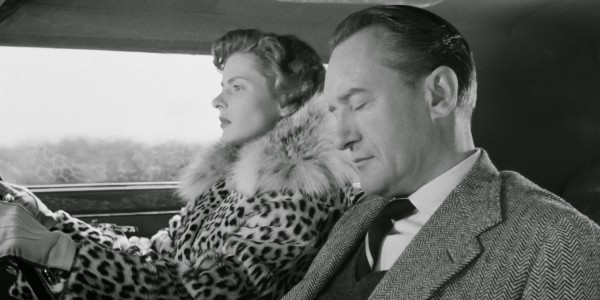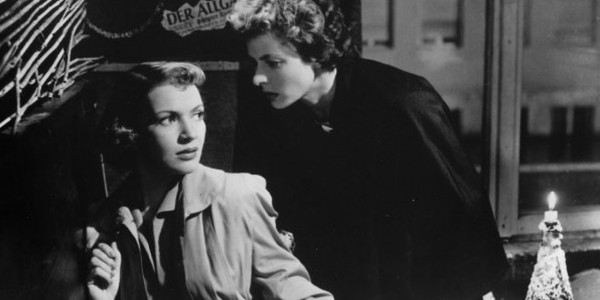Review: The Roberto Rossellini and Ingrid Bergman Collection
"Between Italian Neo-Realism and Hollywood Glamour"
In 1948, a letter laid the foundation for a scandalous love affair which lasted for almost a decade and produced three children and five feature films. Its author was Ingrid Bergman, one of Hollywood's most popular and glamorous stars. After seeing
Rome, Open City and
Paisan, the
Casablanca-star was struck with admiration for director Roberto Rossellini and expressed her desire to collaborate with him, despite the fact that she only knew one sentence of Italian ("Ti amo"). The filmmaker duly obliged and offered her the lead in
Stromboli. Rossellini and Bergman were both married at the time, but their relationship immediately moved beyond the professional level and an international scandal ensued. Until their divorce in 1957, the couple collaborated closely on a number of films. The movies performed disastrously with audiences and critics alike, but they found support from the
Cahiers du Cinéma and particularly Eric Rohmer. Since then, the films have been re-evaluated and three of them are now being re-released for home viewing. The BFI's box-set offers complete restorations of
Stromboli - Land of God, Journey to Italy, and
Fear on Blu-ray. The films are also available individually on DVD.

Roberto Rossellini was one of the figureheads of Italian neorealism which emerged in the aftermath of the Second World War. These films were seen as an antidote to Hollywood escapism. They tell stories set amongst the working class, are filmed on real locations and frequently use non-professional actors. In
Stromboli, the strongest feature in the collection, we can witness Rossellini transition from his neorealist roots to his later, more conventional work. After the war, Karen (Bergman) marries Antonio a simple fisherman (Mario Vitale) and follows him to the actively volcanic island of Stromboli. For Antonio this is home, but for Karen the island quickly transforms into a desolate prison of desperation. Most of the village's population has left for America and those who are left fail to accept the tall blonde as one of their own. The local priest and a lighthouse keeper provide some support, but Karen cannot feel comfortable and eventually she decides to defy the volcano.
Rossellini makes brilliant use of the locations to complement Bergman's performance convey his protagonist's desperation. The volcano is a site of spectacular beauty, but in
Stromboli it is the villain of the piece. It radiates danger in a hostile environment, a powerful metaphor for Antonio's fiery passion and the locals' mistrust of outsiders. Despite the presence of a Hollywood star, the film remains faithful to its art cinema roots and Rossellini takes the time to reminisce about ordinary life (the film's most spectacular set-piece depicts a realistic tuna-raid) and spiritual questions.

In 1954's
Journey to Italy, Bergman is joined by George Sanders on the peninsula. They play a married couple who confront their dormant relationship troubles during a week-long trip to Naples. Once again desperation is the dominant emotion, but like Mount Vesivus is calmer than Stromboli, Katherine is much more restrained than Karen. While her husband unsuccessfully pursues a girl on a nearby island, we follow Bergman to the sites and attractions of the city. Cynics will question the involvement of the local tourist board, but Rossellini makes sure these trips have meaning. Sightseeing creates a link between the past and the present, between history and memory. The only thing separating the married couple and two people who died in Pompeii are a couple of millennia. François Truffaut's claim that
Journey to Italy marks the first modern film seems hyperbolic in retrospect, but it still holds up as fascinating viewing.
For
Fear, the final collaboration with Bergman
, Rossellini moves into the territory of genre cinema with mixed results. In this Hitchcockian noir-thriller based on a German novel by Stefan Zweig
, Bergman has to hide an affair from her husband, which becomes increasingly difficult when her lover's ex turns up at her doorstep demanding large sums of money. There are some cleverly executed twists, turns and powerplays, but the film never manages to captivate. Are we supposed to feel sorry for Bergman's hopeless situation? Or are we supposed to gleefully enjoy her suffering?
Fear never settles on a tone and the rushed ending is similar to the conclusion of
Journey to Italy, but has no credibility whatsoever in this case.
 Special Features:
Special Features: a documentary about Magnani-Rossellini-Bergman scandal; Ingrid Bergman at the National Film Theatre; video essay by Tag Gallagher; Italian cut of
Journey to Italy; audio commentary by academic Laura Mulvey for
Journey to Italy; Isabella Rossellini's tribute to her father; illustrated booklet.
Pros
- Stromboli
- Journey to Italy
 Roberto Rossellini was one of the figureheads of Italian neorealism which emerged in the aftermath of the Second World War. These films were seen as an antidote to Hollywood escapism. They tell stories set amongst the working class, are filmed on real locations and frequently use non-professional actors. In Stromboli, the strongest feature in the collection, we can witness Rossellini transition from his neorealist roots to his later, more conventional work. After the war, Karen (Bergman) marries Antonio a simple fisherman (Mario Vitale) and follows him to the actively volcanic island of Stromboli. For Antonio this is home, but for Karen the island quickly transforms into a desolate prison of desperation. Most of the village's population has left for America and those who are left fail to accept the tall blonde as one of their own. The local priest and a lighthouse keeper provide some support, but Karen cannot feel comfortable and eventually she decides to defy the volcano.
Rossellini makes brilliant use of the locations to complement Bergman's performance convey his protagonist's desperation. The volcano is a site of spectacular beauty, but in Stromboli it is the villain of the piece. It radiates danger in a hostile environment, a powerful metaphor for Antonio's fiery passion and the locals' mistrust of outsiders. Despite the presence of a Hollywood star, the film remains faithful to its art cinema roots and Rossellini takes the time to reminisce about ordinary life (the film's most spectacular set-piece depicts a realistic tuna-raid) and spiritual questions.
Roberto Rossellini was one of the figureheads of Italian neorealism which emerged in the aftermath of the Second World War. These films were seen as an antidote to Hollywood escapism. They tell stories set amongst the working class, are filmed on real locations and frequently use non-professional actors. In Stromboli, the strongest feature in the collection, we can witness Rossellini transition from his neorealist roots to his later, more conventional work. After the war, Karen (Bergman) marries Antonio a simple fisherman (Mario Vitale) and follows him to the actively volcanic island of Stromboli. For Antonio this is home, but for Karen the island quickly transforms into a desolate prison of desperation. Most of the village's population has left for America and those who are left fail to accept the tall blonde as one of their own. The local priest and a lighthouse keeper provide some support, but Karen cannot feel comfortable and eventually she decides to defy the volcano.
Rossellini makes brilliant use of the locations to complement Bergman's performance convey his protagonist's desperation. The volcano is a site of spectacular beauty, but in Stromboli it is the villain of the piece. It radiates danger in a hostile environment, a powerful metaphor for Antonio's fiery passion and the locals' mistrust of outsiders. Despite the presence of a Hollywood star, the film remains faithful to its art cinema roots and Rossellini takes the time to reminisce about ordinary life (the film's most spectacular set-piece depicts a realistic tuna-raid) and spiritual questions.
 In 1954's Journey to Italy, Bergman is joined by George Sanders on the peninsula. They play a married couple who confront their dormant relationship troubles during a week-long trip to Naples. Once again desperation is the dominant emotion, but like Mount Vesivus is calmer than Stromboli, Katherine is much more restrained than Karen. While her husband unsuccessfully pursues a girl on a nearby island, we follow Bergman to the sites and attractions of the city. Cynics will question the involvement of the local tourist board, but Rossellini makes sure these trips have meaning. Sightseeing creates a link between the past and the present, between history and memory. The only thing separating the married couple and two people who died in Pompeii are a couple of millennia. François Truffaut's claim that Journey to Italy marks the first modern film seems hyperbolic in retrospect, but it still holds up as fascinating viewing.
For Fear, the final collaboration with Bergman, Rossellini moves into the territory of genre cinema with mixed results. In this Hitchcockian noir-thriller based on a German novel by Stefan Zweig, Bergman has to hide an affair from her husband, which becomes increasingly difficult when her lover's ex turns up at her doorstep demanding large sums of money. There are some cleverly executed twists, turns and powerplays, but the film never manages to captivate. Are we supposed to feel sorry for Bergman's hopeless situation? Or are we supposed to gleefully enjoy her suffering? Fear never settles on a tone and the rushed ending is similar to the conclusion of Journey to Italy, but has no credibility whatsoever in this case.
In 1954's Journey to Italy, Bergman is joined by George Sanders on the peninsula. They play a married couple who confront their dormant relationship troubles during a week-long trip to Naples. Once again desperation is the dominant emotion, but like Mount Vesivus is calmer than Stromboli, Katherine is much more restrained than Karen. While her husband unsuccessfully pursues a girl on a nearby island, we follow Bergman to the sites and attractions of the city. Cynics will question the involvement of the local tourist board, but Rossellini makes sure these trips have meaning. Sightseeing creates a link between the past and the present, between history and memory. The only thing separating the married couple and two people who died in Pompeii are a couple of millennia. François Truffaut's claim that Journey to Italy marks the first modern film seems hyperbolic in retrospect, but it still holds up as fascinating viewing.
For Fear, the final collaboration with Bergman, Rossellini moves into the territory of genre cinema with mixed results. In this Hitchcockian noir-thriller based on a German novel by Stefan Zweig, Bergman has to hide an affair from her husband, which becomes increasingly difficult when her lover's ex turns up at her doorstep demanding large sums of money. There are some cleverly executed twists, turns and powerplays, but the film never manages to captivate. Are we supposed to feel sorry for Bergman's hopeless situation? Or are we supposed to gleefully enjoy her suffering? Fear never settles on a tone and the rushed ending is similar to the conclusion of Journey to Italy, but has no credibility whatsoever in this case.
 Special Features: a documentary about Magnani-Rossellini-Bergman scandal; Ingrid Bergman at the National Film Theatre; video essay by Tag Gallagher; Italian cut of Journey to Italy; audio commentary by academic Laura Mulvey for Journey to Italy; Isabella Rossellini's tribute to her father; illustrated booklet.
Special Features: a documentary about Magnani-Rossellini-Bergman scandal; Ingrid Bergman at the National Film Theatre; video essay by Tag Gallagher; Italian cut of Journey to Italy; audio commentary by academic Laura Mulvey for Journey to Italy; Isabella Rossellini's tribute to her father; illustrated booklet.